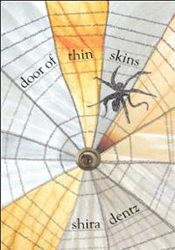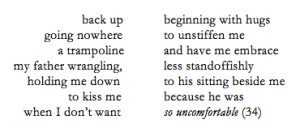
Organizational principles. Shira Dentz’s door of thin skins has a few. Persona. Metaphor. Hearts. Birds. Diagrams. What Dentz does so well in this collection is to connect then turn inside-out these organizations. An artichoke’s petals turn into a bird’s wings. The pith and meat of that same artichoke turn into the speaker. Slipping through becomes the organizational principle. The speaker herself turns into the absent heart of an artichoke. In the poem “10. Hands” she ends, “and the hole between the wings, where there should have been a body, was me.” The collection successfully creates lyrical holes in the middle of the narrative through which the reader can step, skipping over the more lurid parts of scene-making and character development in order to get to the heart of the matter.
Some of the most interesting work that is coming out is hybrid in form, crossing genre. Shira Dentz’s door of thin skins combines prose, poetry, and diagrams to recount a narrative. The diagrams and poems serve to point out holes in the story. The reader falls through genre, onto other pages, making associative and metaphorical meaning. Dentz makes it clear that narratives always have holes.
The narrative of door of thin skins seems straightforward. A psychologist abuses or at least misuses his patient, making her sit on her lap, kissing her. He fondles her breasts. In the poem “Circumflex,” the mid-point of the book, the organization of the narrative turns inside out. The fingers and tongue that the speaker tried to use to understand her space, through words and writing, the way she organizes her world, understands it, grasps it, gets turned around on her. The poem, cut in half with a wide gutter of non-understanding in the middle of the lines, rails against the lack of contour, the way Dr. Abe, the psychologist, has turned her own tools—her words, her writing against her. By sexualizing his patient, he disempowers her. You, with tongue and fingers, stop talking, come fondle me, Dr. Abe seems to say.

To deflect indictment, Dr. Abe, complains about the speaker,
“You’re supposed to be an artist!” (35)
“You need a boyfriend or I wouldn’t be doing this.” (44)
“I wonder why you didn’t enjoy your father’s advances,” he accuses. (45)
“You’re supposed to be a writer.”
And, again, “You used to be an artist,” (74).
Dr. Abe’s charges against the speaker complicate the accusations. Within the abuse is another disguised abuse—the most accepted form of abuse: psychotherapy. Where else can you sit back, insult someone, and get paid for it? The more lyrical moments in the poem sear a hole into that blanket of normalized psychologic cruelty. Against the backdrop of a normalizing narrative, describing the normalized insulting language of abuse, Dentz sets spiraling poems that ask “What the hell?” Into this rabbit-hole the speaker descends taking with her narrative through-line, generic constancy, and linguistic quagmires to search for a way to make it clear that even a wild speaker can delineate between caregiver and abuser. When narratives compete, father’s narratives with daughter’s, psychotherapist’s with patient’s, the speaker sneaks out through one of the holes she makes for herself by forward-moving narrative into lyric or graphic.
 The central poem that delivers the prurient also illustrates the divide between narrative and lyric. Set in two columns, the right side of the poem describes breast fondling and kissing in regular, climax-building sentences. The left side of the poem slips more lyrically, associatively. From “my father wrangling,/ holding me down/to kiss me” falls into “the zero at the center of an egg/ nothing happening/–dragonfly body” which falls into “I wish I had a piano/to portray the landscape/without hills.” The lyric keeps the narrative alive by asking what? What? What? Otherwise, the story is as dead as the past. Power relationships are fucked up. Got it. But the lyric pokes a hole in the “got it.” The past tense of narrative is a myth. The fucking up continues on forever, still and now. And over-kissing fathers and fingering psychologist are silently, still and now, indicted in the gulf between.
The central poem that delivers the prurient also illustrates the divide between narrative and lyric. Set in two columns, the right side of the poem describes breast fondling and kissing in regular, climax-building sentences. The left side of the poem slips more lyrically, associatively. From “my father wrangling,/ holding me down/to kiss me” falls into “the zero at the center of an egg/ nothing happening/–dragonfly body” which falls into “I wish I had a piano/to portray the landscape/without hills.” The lyric keeps the narrative alive by asking what? What? What? Otherwise, the story is as dead as the past. Power relationships are fucked up. Got it. But the lyric pokes a hole in the “got it.” The past tense of narrative is a myth. The fucking up continues on forever, still and now. And over-kissing fathers and fingering psychologist are silently, still and now, indicted in the gulf between.
The persona here is consistent and well-voiced. Full-on chunks of prose stretch throughout the collection. The book is so collected, so much of a consistent persona and a palpable narrative, it may well be a book of prose except for these metaphorical magic tricks. I picture the speaker on stage, stepping into a hoop, pulling up cloth around herself and turning from a bird into a pocket.
“I was the artist who’d
drawn the tunnel we passed through on our way to the sound of his voice (43)
Finally we arrive, from the multiple organizational principles, to one unifying principle: the hole. The diagrams perform holes the page, perforating the edges of text, the cubed paragraphs and parallel lines.
To create holes in the narrative to force poetry but also holes in the paper itself—a way to move through the book non-sequentially so that we don’t amass a straightforward, smooth narrative but a multi-edged, slippery, worm-holed, fracture with a lyrical bite.




